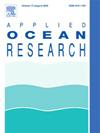当前一种新型边网与底网混合浮网箱设计评价
IF 4.3
2区 工程技术
Q1 ENGINEERING, OCEAN
引用次数: 0
摘要
浮动网箱系统是海洋水产养殖的主要技术。虽然传统的HDPE网箱与光纤网的研究已经得到了广泛的研究,但需要强调的是,对配备金属网的浮动网箱以及金属纤维混合网箱的性能研究仍然相对有限。在水槽试验的基础上,主要研究了边底混合网箱的方形和八角形网箱在水流中的净变形和阻力,以及底重的影响。结果表明,在较低流速下,增加底部重量可以有效降低笼形变形,但在较高流速下效果较差,流速对阻力的影响更为显著。使用金属底网对笼的性能影响有限,主要是由于底部框架与水流平行。HN-FN(混合纤维线和纤维网)和WN-FN(金属线和纤维网)笼在高流速下保持60%以上的体积。然而,WN-FN保持架的阻力明显高于HN-FN保持架,这表明HN-FN配置在大流量条件下提供了更有利的结构稳定性和减少阻力之间的平衡。无论在低流速还是高流速下,八角形保持器的性能都优于方形保持器,尤其是在高流速下。然而,方形网箱具有明显的优势,例如更简单的结构,更容易维护,并改善了水的交换。此外,底部框架和垂直钢丝绳有效地调节笼的变形,保持结构的完整性。这些发现可以为优化管网系统设计提供有价值的指导和建议,以提高管网系统在不同流量条件下的性能。本文章由计算机程序翻译,如有差异,请以英文原文为准。
Evaluation of a novel design of floating net cage with hybrid side and bottom nets in current
The floating cage system is the dominant technology used for marine aquaculture. While traditional HDPE cages with fiber nets have been extensively studied, it is important to highlight that research on the performance of floating cages equipped with metal nets, as well as those with hybrid metal-fiber nets, remains relatively limited. Based on flume experiments, we mainly investigated the net deformation and drag force of the square and octagonal cages featured with hybrid side and bottom nets in currents, together with the effect of bottom weight. The results indicate that increasing bottom weight effectively reduced cage deformation at lower flow velocities but became less effective at higher velocities, where the influence of flow velocity on drag was more significant. The use of a metal bottom net had a limited impact on cage performance, primarily due to the alignment of the bottom frame parallel to the water flow. Both HN-FN (hybrid fiber-wire and fiber net) and WN-FN (wire and fiber net) cages retain a similar volume of over 60 % at high flow velocities. However, the drag on WN-FN cages is significantly higher than that on HN-FN cages, indicating that the HN-FN configuration offers a more advantageous balance between structural stability and reduced drag under high flow conditions. Octagonal cages consistently outperform square cages at both lower and higher flow velocities, particularly excelling at higher velocities. However, square cages offer distinct advantages, such as simpler construction, easier maintenance, and improved water exchange. Moreover, the bottom frame and vertical wire ropes effectively regulate cage deformation and preserve structural integrity. These findings can provide valuable guidelines and recommendations for optimizing net system design to enhance performance under diverse flow conditions.
求助全文
通过发布文献求助,成功后即可免费获取论文全文。
去求助
来源期刊

Applied Ocean Research
地学-工程:大洋
CiteScore
8.70
自引率
7.00%
发文量
316
审稿时长
59 days
期刊介绍:
The aim of Applied Ocean Research is to encourage the submission of papers that advance the state of knowledge in a range of topics relevant to ocean engineering.
 求助内容:
求助内容: 应助结果提醒方式:
应助结果提醒方式:


